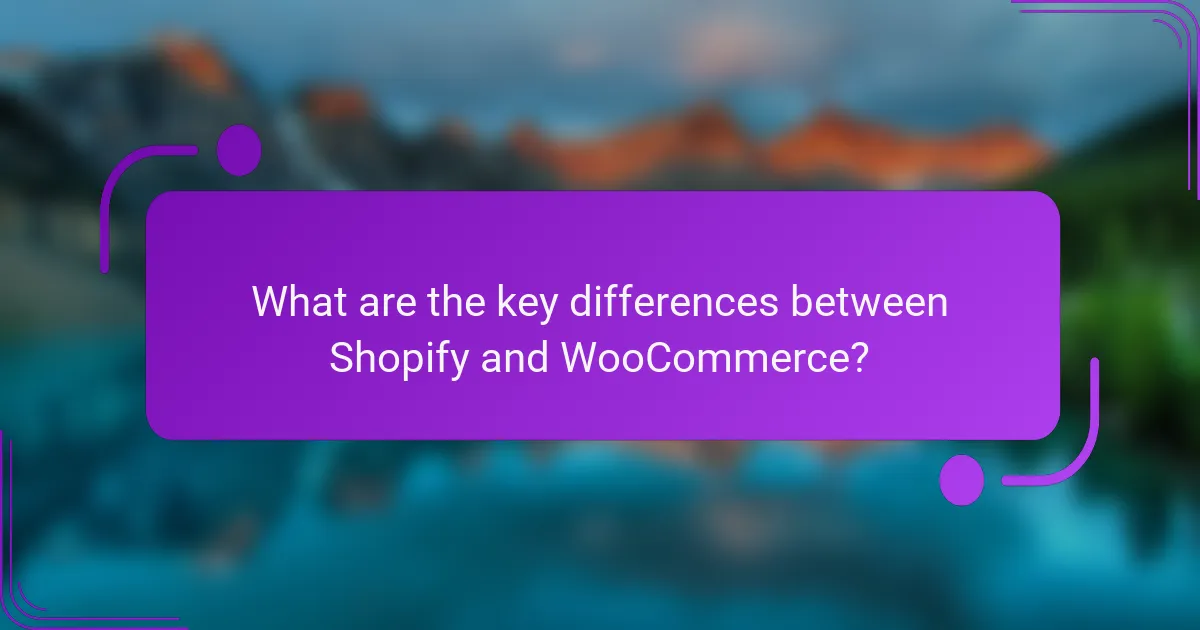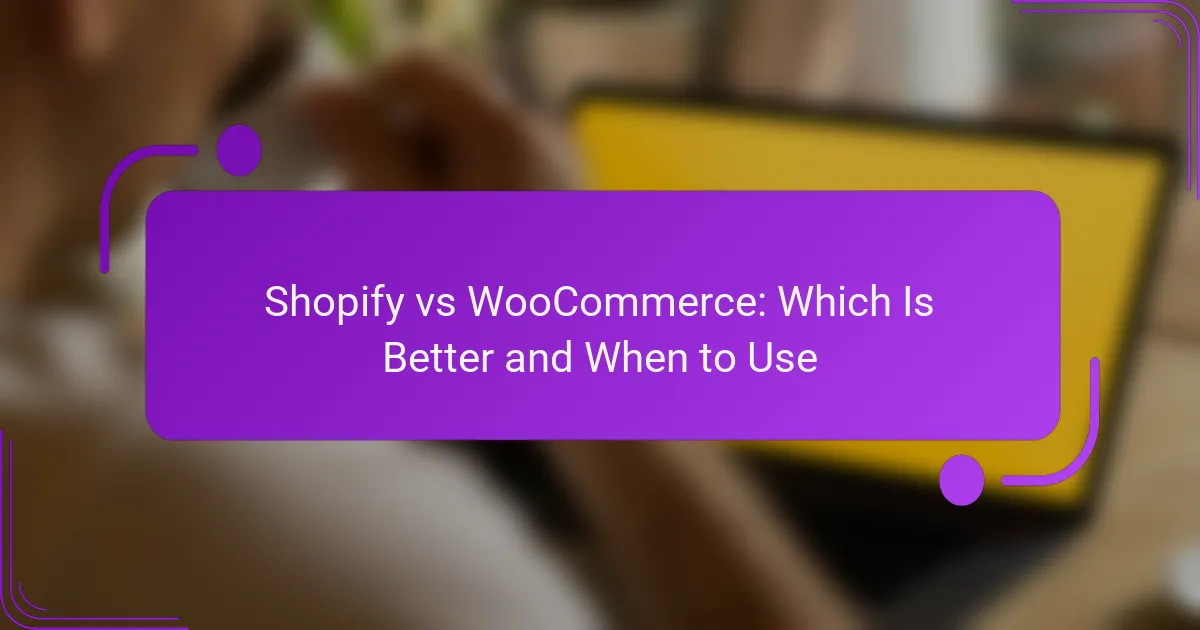When choosing between Shopify and WooCommerce for your eCommerce needs, it’s essential to understand their key differences. Shopify offers a user-friendly, fully hosted solution ideal for those seeking simplicity and scalability, while WooCommerce provides a customizable platform that requires more technical expertise and operates within WordPress. Each platform has unique pricing structures, making it crucial to assess your business requirements before making a decision.

Which platform is better for eCommerce in the USA?
Shopify is often considered the better platform for eCommerce in the USA due to its user-friendly interface and built-in scalability features. WooCommerce, while powerful, requires more technical knowledge and can be more complex to set up and manage.
Shopify offers ease of use and scalability
Shopify is designed for users who want a straightforward setup and management experience. With its drag-and-drop interface, even those with minimal technical skills can launch an online store quickly. The platform also provides various templates and apps to enhance functionality without extensive coding knowledge.
Scalability is another key advantage of Shopify. As your business grows, Shopify can easily accommodate increased traffic and sales volume without requiring significant changes to your setup. This makes it ideal for entrepreneurs looking to expand their operations over time.
WooCommerce provides customization and flexibility
WooCommerce is a plugin for WordPress that offers extensive customization options, making it suitable for users who want to tailor their online store to specific needs. With access to thousands of themes and plugins, you can create a unique shopping experience that aligns with your brand.
However, this flexibility comes with a trade-off. WooCommerce requires a greater level of technical expertise, especially when it comes to hosting, security, and maintenance. Users must be prepared to handle updates and potential issues, which can be a barrier for those seeking a more hands-off approach.

What are the key differences between Shopify and WooCommerce?
Shopify and WooCommerce are both popular e-commerce platforms, but they differ significantly in their structure and functionality. Shopify is a fully hosted solution, while WooCommerce is a plugin that operates on WordPress, which impacts ease of use, customization, and overall management.
Shopify is a hosted solution
Shopify is a cloud-based e-commerce platform that provides everything needed to set up an online store, including hosting, security, and payment processing. This means users can focus on building their store without worrying about technical details like server management or software updates.
One of the main advantages of Shopify is its user-friendly interface, which allows even those with minimal technical skills to create and manage an online store. However, this convenience comes at a cost, as Shopify charges monthly fees and transaction fees, which can add up depending on sales volume.
WooCommerce is a plugin for WordPress
WooCommerce is an open-source plugin that integrates with WordPress, transforming a standard website into a fully functional e-commerce store. This flexibility allows users to customize their stores extensively, using various themes and plugins available in the WordPress ecosystem.
While WooCommerce offers greater control and customization options, it requires more technical knowledge to set up and maintain. Users must handle hosting, security, and updates themselves, which can be a drawback for those seeking a hassle-free experience. Additionally, costs can vary widely based on hosting choices and any premium plugins or themes used.

What are the pricing structures for Shopify and WooCommerce?
Shopify and WooCommerce have distinct pricing structures that cater to different business needs. Shopify operates on a subscription model with fixed monthly fees, while WooCommerce’s costs can vary significantly based on hosting and additional plugins.
Shopify has monthly subscription fees
Shopify requires users to pay a monthly subscription fee, which typically ranges from around $29 to $299, depending on the plan selected. Each plan includes hosting, security, and support, making it a straightforward option for those who prefer an all-in-one solution.
Additionally, Shopify charges transaction fees unless you use its integrated payment processor, Shopify Payments. This can add to the overall cost, especially for businesses with high sales volumes.
WooCommerce has variable costs based on hosting and plugins
WooCommerce is a free plugin for WordPress, but its total cost can vary widely. Users must pay for web hosting, which can range from approximately $5 to $50 per month, depending on the provider and plan. This flexibility allows for tailored solutions but requires more management.
Moreover, additional costs may arise from purchasing premium themes and plugins to enhance functionality. Businesses should budget for these extras, which can add anywhere from a few dollars to several hundred dollars annually, depending on their needs.

When should I choose Shopify over WooCommerce?
Choose Shopify over WooCommerce if you need a user-friendly platform that allows for quick setup and requires minimal technical skills. Shopify is ideal for businesses that prioritize ease of use and reliable support without the need for extensive customization.
For quick setup and minimal technical skills
Shopify is designed for users who want to launch their online store quickly. With its intuitive interface, you can set up a store in just a few hours, even if you have limited technical knowledge. The platform provides a variety of templates and built-in features that simplify the process.
Unlike WooCommerce, which requires you to manage hosting and security, Shopify handles these aspects for you. This means you can focus on your products and marketing rather than technical details, making it a suitable choice for small business owners or entrepreneurs just starting out.
For businesses needing reliable support
If your business requires dependable customer support, Shopify excels in this area. The platform offers 24/7 customer service through various channels, including chat, email, and phone. This ensures that any issues you encounter can be resolved quickly, minimizing downtime and frustration.
In contrast, WooCommerce relies on community forums and third-party hosting providers for support, which can lead to delays in assistance. For businesses that value prompt and effective support, especially during critical sales periods, Shopify is a more reliable option.

When should I choose WooCommerce over Shopify?
Choose WooCommerce over Shopify if you need extensive customization and flexibility for your online store. It is particularly beneficial for businesses already using WordPress, allowing for seamless integration and control over various aspects of the site.
For extensive customization options
WooCommerce offers a high level of customization, making it ideal for businesses that require unique features or specific functionalities. You can modify almost every aspect of your store, from product pages to checkout processes, using various plugins and custom code.
For example, if you want to implement a specific payment gateway or a unique shipping method, WooCommerce allows you to do so with relative ease. This flexibility can be crucial for businesses with niche requirements or those looking to create a distinct brand experience.
For businesses already using WordPress
If your business is already built on WordPress, WooCommerce is a natural choice. It integrates seamlessly with your existing site, allowing you to leverage your current content and SEO strategies without starting from scratch.
Using WooCommerce in this scenario can save time and effort, as you can maintain a consistent look and feel across your website. Additionally, you can utilize existing WordPress plugins to enhance your e-commerce functionality, making it a practical option for those already familiar with the platform.

What are the SEO capabilities of Shopify and WooCommerce?
Shopify and WooCommerce both offer distinct SEO capabilities that cater to different user needs. Shopify provides built-in features that simplify optimization, while WooCommerce allows for extensive customization through advanced plugins.
Shopify has built-in SEO features
Shopify comes with a range of built-in SEO features that make it easy for users to optimize their online stores. These include customizable title tags, meta descriptions, and automatic sitemap generation, which help improve visibility on search engines.
Additionally, Shopify’s clean code structure and fast loading times contribute positively to SEO performance. Users can also easily edit alt text for images, which is crucial for image search optimization.
WooCommerce allows for advanced SEO plugins
WooCommerce, being a WordPress plugin, offers the flexibility to enhance SEO through various advanced plugins like Yoast SEO and All in One SEO Pack. These tools provide comprehensive features such as keyword optimization, readability analysis, and social media integration.
With WooCommerce, users can implement more complex SEO strategies, including schema markup and advanced analytics tracking. This level of customization is ideal for businesses looking to fine-tune their SEO efforts for better search rankings.

What are the payment processing options available?
Both Shopify and WooCommerce offer a variety of payment processing options, allowing merchants to choose solutions that best fit their business needs. Shopify provides built-in payment gateways, while WooCommerce allows for extensive integrations with numerous third-party processors.
Shopify supports multiple payment gateways
Shopify includes its own payment solution, Shopify Payments, which simplifies transactions and eliminates third-party fees. Additionally, it supports popular gateways like PayPal, Stripe, and Authorize.Net, giving users flexibility in how they accept payments.
Merchants can easily set up these gateways through the Shopify admin panel. It’s essential to consider transaction fees associated with each gateway, as they can vary significantly, typically ranging from 2% to 3% per transaction.
WooCommerce integrates with various payment processors
WooCommerce is highly adaptable, allowing integration with a wide range of payment processors such as PayPal, Square, and Stripe. This flexibility enables users to select the best options based on their target market and transaction needs.
Setting up payment processors in WooCommerce involves installing plugins and configuring settings, which can be straightforward for users familiar with WordPress. However, merchants should be aware of potential fees and ensure compliance with local regulations, especially when dealing with international payments.
